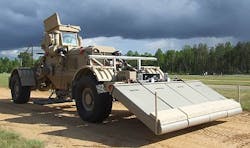Army to buy six IED-hunting ground-penetrating radars from NIITEK for pre-procurement testing
Officials of the Army Contracting Command at Aberdeen Proving Ground, Md., have announced plans to buy six Husky Mounted Detection Systems (HMDS) ground-penetrating radar (GPR) from Non-Intrusive Technology Inc.(NIITEK) in Dulles, Va., for advanced testing in preparation of a long-term HMDS procurement. The value of the contract has not yet been negotiated.
The HMDS program is becoming an Army program of record (POR), and officials will use the six HMDS systems to help establish a baseline and configuration control for the HMDS and its ground-penetrating radar technology. NIITEK has been developing the HMDS since 2006.
Officials of the Army Contracting Command are negotiating the contract with NIITEK on behalf of the Army Project Manager Close Combat System (PM CCS) at Picatinny Arsenal, N.J.
The HMDS is a counter-IED system able to detect underbelly IEDs and antitank landmines buried in primary and secondary roads. As a result, the HMDS is vital to route clearance packages (RCP), Army officials say. The system is a combination of the NIITEK VISOR 2500 ground-penetrating radar and the Husky vehicle from Critical Solutions International Inc. in Carrollton, Texas.
The HMDS helps the Army quickly clear roadways of anti-tank mines, roadside bombs, and other IEDs. The NIITEK VISOR 2500 ground-penetrating radar detects metallic and non-metallic explosive hazards, pressure plates, and antitank mines. It combines advanced real-time automatic-target-recognition algorithms, integrated metallic and non-metallic threat detection, automatic precision marking, and software in a ruggedized, supportable package.
NIITEK’s multi-panel high-performance VISOR ground-penetrating radar functions on manned, blast-resistant vehicles to provide rapid ability to scope out anti-vehicle landmines and other explosive hazards on main supply routes and additional open areas as needed, NIITEK officials say.
NIITEK’s ground-penetrating radar and an optional metal detector, when mounted on manned, blast-resistant vehicles, provides a rapid ability to scope out anti-vehicular landmines or any other type of buried explosive hazard.
NIITEK’s VISOR 2500 ground-penetrating radar is designed for buried mine and similar explosives detection using ultra-wideband ground-penetrating radar arrays and automatic target recognition. The system uses ultra-wide-bandwidth impulses, has a high signal to clutter ratio, low radar cross-section, is lightweight, and offers low power consumption, NIITEK officials say.
For more information contact NIITEK online at www.niitek.com, or the Army Project Manager Close Combat System (PM CCS) at www.pica.army.mil/pmccs.

